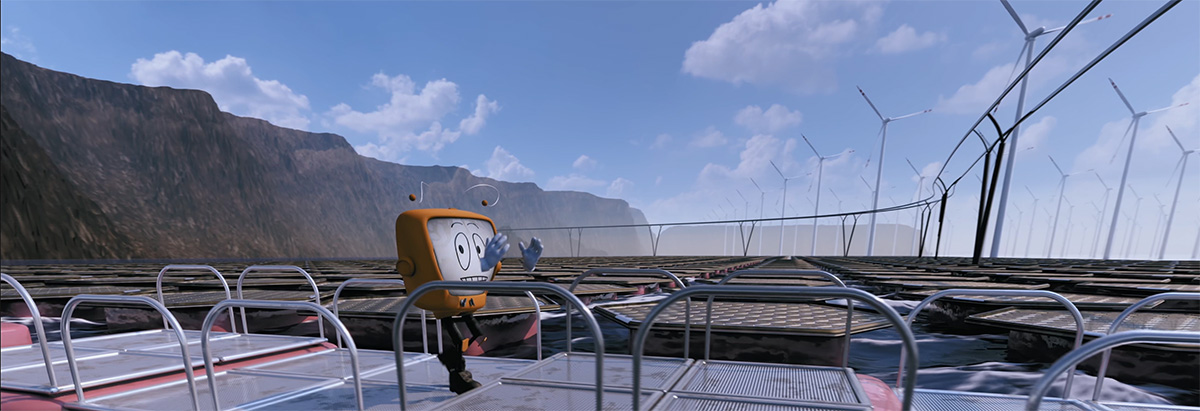Utopia
We time travel to the far future: Humanity has written an amazing success story. After years of progress and cooperation, we have entered a new era of peace and prosperity.

One of the achievements of humanity in the future is the advancement in technology. Through the use of artificial intelligence, quantum computing, nano- and biotechnology and the use of renewable energy we have advanced as a species and embarked on a path to a sustainable future.
Food Supply
The use of underwater algae farms as a food source and CO2 sink to reduce pressure on land-based agriculture has prooved to be a promising area of research and development. Algae are photosynthetic organisms that are grown in water and can absorb CO2 from the atmosphere. Algae can also be used as a source of protein, carbohydrates, and other nutrients. Seaweed grows rapidly and can be harvested without land, freshwater or fertilizer.

In addition, algae are highly nutritious and can be used as a food and biofuel source. Of course, with large-scale algae farms, it is important to ensure that there is no negative impact on the marine environment. However, used correctly, algae farms can even help increase and safeguard marine biodiversity, similar to coral reefs. This among other achievement allowed humanity to overcome poverty and hunger. We have managed to grow and distribute food more effectively. At the same time we have also improved economic systems and social structure to ensure a more equitable distribution of wealth and a better quality of life for all. It was an important realization that the climate crisis, resource crisis, lack of access to education and poverty were tightly interconnected and a holistic approach solved them all together.
Mobility
The swiftpod rail network spans the entire globe: a high speed public transport system for goods and people that can can be used freely by anyone. Electrically powered and autonomously navigating pods move silently on frictionless magnetic rails not interfering with the habbitat below.

The rail system is not a mere connection from A to B, but a highly redudant network that long replaced all paved roads. There are no dedicated stations as the pod can be lowered and unhooked anywhere along the track. Every person can access a swiftpod within walking distance.
Renewable Energy
Photovoltaic (PV) panels have become the cheapest source of electricity in most parts of the world a long time ago. Together with offshore windparks, hydro and geothermal power as well as intelligent power storage solutions demand of the Earths power requirements have now been easily covered independent of local weather geographical specifics. With ocean areas included the required photovoltaic surface area is less than 0.1% of the Earth's total surface. As technology advanced it also became much greatly more energy efficient.

But it was also an important realization that technology was not the solution to all problems, and that many solutions had long been obvious and made possible by social acceptance and commitment enabled by high quality education accessible by everyone.
Nano Cosmos and Nature Reserves
50 percent of Earths surface area have been declared nature reserves and are left alone entirely. Important to note here is that these nature reserve areas are all interconnected and not isolated islands on the map. Biodiversity in the nanoworld with fungi, bacteria and other microbes is also important as everything is interconnected and influencing each other.

Space Exploration
The exoplanet Gliese 667Cc is located about 22 light years from Earth. Even though this exoplanet is located within the habitable zone of its host star resulting in an optimal temerpature range for life to exist and an athmosphere there is no indication that life is more than a singularity in the known universe: On Earth - All possible effort have been made to protect and nurture it here.

Personal Well-Being and Space
Finally, we have also made great progress in the area of interpersonal relations. We have focused on accepting and appreciating our differences, and we have learned to work together to achieve common goals. The general well-being of people (as well as the environment and animals) is at the heart of modern society, and cities provide much space for social interaction and personal development. Inspired by biotechnology, buildings are no longer built but grown: self-repairing thermal insulation made of natural materials, with sun shade and air circulation like an organism - similar to fungi. People enjoy their time with creativity, discovery, socialising and research - work as passion and fulfilment. All repetitive, mundane activities have long since been taken over by robots and artificial intelligence.

Overall, humanity has had an incredible success story in the future. Through the use of technology, science, and cooperation, we have created a world that is more just, sustainable, and peaceful than ever before. We have changed the world and set out to create a better future for everyone, including all living beeings and our environment.
It required a vision to turn these ideas into reality: a virtual reality that makes such a world comprehensible and tangible.

 Wechsel auf Deutsch
Wechsel auf Deutsch






